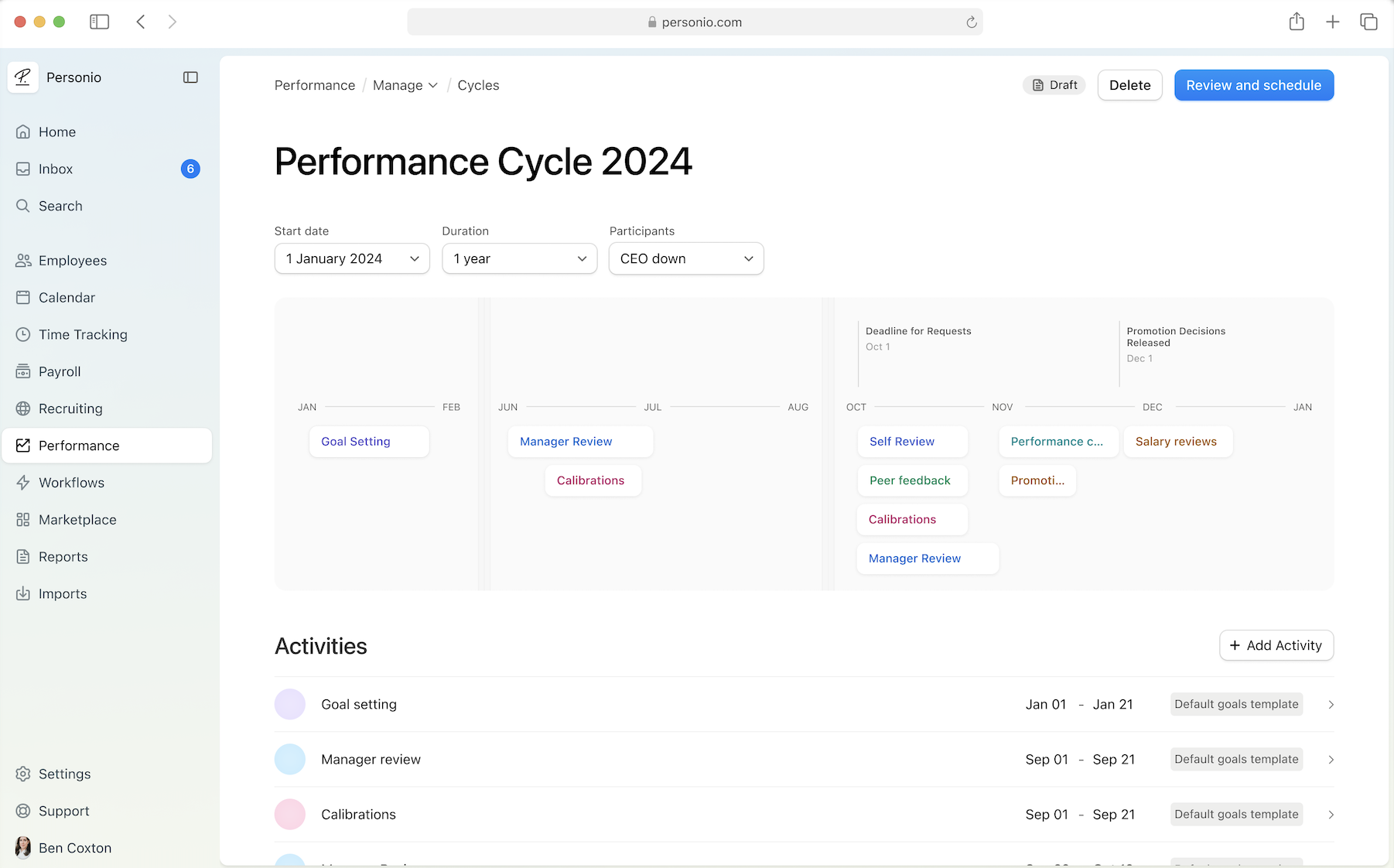
Revolutionise your processes
Check out the leading performance review software solutions to transform your workplace evaluations.
Read our guideUnderperforming Employees: How HR Can (& Should) Handle It

In this guide to underperforming employees, we cover everything including: Why employees may be underperforming, what to do at specific, sensitive times and how HR can tackle employee underperformance more generally.
Download our guide to Performance Management today.Contents
- 1How Is Underperforming Defined?
- 2What Are the Top Reasons for Underperformance?
- 3How Do You Identify Employee Underperformance?
- 4What’s The Cost Of Not Dealing With Underperforming Employees?
- 5How Can HR Tackle Underperformance?
- 6When Underperforming Is at Its Trickiest
- 7Can You Improve Employee Underperformance?
- 8How Can HR Software Help With Underperforming Employees?
How Is Underperforming Defined?
Underperformance means performing less well than expected. In a business context, when an employee doesn’t do their job the way you expect them to or doesn’t do it at all, that’s underperformance.
Employee underperformance might involve failing to meet an acceptable standard of work, not complying with work policies and procedures, or demonstrating behaviour that impacts others negatively (like gossiping, showing up late, or not letting others know if they can’t complete work on time).
What is Underperforming at Work?
Employees underperform at work when they don’t do the job that’s required of them. But underperformance doesn’t just mean providing an unsatisfactory work performance.
Other signs of underperformance can include not working well with others, showing signs of inappropriate, negative, or destructive behaviour, antagonism, a failure to meet acceptable standards or violation of rules and regulations.
What Are the Top Reasons for Underperformance?
Not all employee underperformance is intentional or vindictive.
Employees might be rebelling, or behaving in lazy, insubordinate, or disrespectful ways because of reasons which you can (and in many cases – are legally required to) address. Employees might show signs of underperformance because:
They don’t know how to do the job. This could be because they are underqualified, undertrained, have unclear goals, or have a lack of direction.
They don’t know what the expectations are of them, or don’t understand the workplace rules, policies, and acceptable standards of behaviour.
They don’t have the tools or resources to do their job properly.
They’re unhappy – this could be because the company has low morale, or maybe it’s a bad work environment.
They have personality conflicts.
They’re unmotivated.
They’re overworked.
They’re stressed, anxious, or burned out. Roughly 25% of workers are experiencing burnout as a result of the pandemic, while another 19% are feeling burnout for other reasons, according to a study by Eagle Hill Consulting.
They’re bored.
They don’t find the job satisfying, fulfilling, or challenging.
They feel unappreciated, underpaid, or angry about not being promoted, or rewarded.
They don’t know that they’re doing a bad job!
You hired the wrong person for the role, department, or company.
They lied about their abilities during the hiring process.
They just aren’t able to do the job.
In many of these instances, it’s possible to turn employee underperformance around. But if their ability simply doesn’t match the role’s requirements, formal steps must be taken to improve performance or consider dismissing the employee.
Streamline your employee development

Define performance cycles, set goals, give effective feedback and evaluate performance fairly. Put structure on how you grow and retain staff with powerful performance management.
Boost your performanceHow Do You Identify Employee Underperformance?
There are two major types of underperformance:
Competence-related underperformance
Motivation-related underperformance
You can usually identify both of them by spotting behaviour change, or by observing signs that an employee isn’t getting the job done.
A good manager will notice when deadlines are being missed, work quality has declined, or they’re not meeting objectives. Signs like mood changes, low motivation, persistent lateness, or repeated absenteeism can be signs of an underperforming employee.
While a good team can often cover for employees who are having an off day, if customers start to complain, employee underperformance must be addressed immediately.
Learn everything you need to know about performance review templates here.
What’s The Cost Of Not Dealing With Underperforming Employees?
Employee underperformance affects their line manager and their colleagues who have to deal with the consequences of their lack of performance. It creates bad team morale which, in turn, can decrease the whole team’s productivity and increase sickness or absence, especially if their lack of performance is associated with negativity, dishonesty, harassment or bullying.
Underperforming employees can also negatively impact customer satisfaction by not helping them or being unpleasant.
If you keep an underperforming employee for too long then fire them without following the due process they could even sue you for wrongful termination, which could cost a lot in legal fees alone.
Underperforming employees can also cause damage to your brand – particularly if you don’t handle their underperformance sensitively. They may bad-mouth your company to others, or take it to social media.
But the consequences of underperformance go even further: When employees underperform, a business can’t operate at its full capacity. As customers look elsewhere to get their problems solved, revenue falls. If left to fester, underperformance can seriously hurt your bottom line.
How Can HR Tackle Underperformance?
Often, the staff handbook is a good place to start when tackling employee underperformance, as it lays out examples of what ‘good’ looks like, and outlines the basic rules. But when the rulebook isn’t enough, HR needs to step in.
Communication is key: Start with an informal chat. Explain the issues that have been observed. Give examples. Listen to their response carefully and thoughtfully and try to figure out a solution to any problems.
The best way of improving underperformance is by identifying its root cause. It’s important to do this in a non-judgmental way by seeking to understand the issues behind their underperforming, rather than blaming them, or behaving antagonistically. You might discover:
They need additional tools, resources, or training to do their job better
There are issues like illness, stress, bullying, harassment, or a toxic work environment.
At the end of the meeting make sure everyone is clear about your expectations of their future behaviour. Explain where they are not performing, remind them about the goals/targets (they may have forgotten) and make sure they have all the resources, tools, and training (or learning from other colleagues) about how to make sure they can improve their performance.
Providing good, constructive feedback is an art form.
Help them get better. Agree on an action plan – often known as a performance improvement plan (PIP). Set SMART (specific, measurable, achievable, realistic, and time-bound) objectives and agree on a timeline for when these goals will be met.
These must be fair and reasonable – not just because it’s the right thing to do, but because it’s an important part of the dismissal process if you end up needing to go this route. Then monitor their performance.
Acknowledge their efforts. Positive feedback, a kind word saying thank you, and congratulations on a job well done can make a massive difference to any employee – it may even turn an underperforming employee into a positive and productive one.
Streamline your employee development

Define performance cycles, set goals, give effective feedback and evaluate performance fairly. Put structure on how you grow and retain staff with powerful performance management.
Boost your performanceWhen Underperforming Is at Its Trickiest
Employee underperformance can be an issue at any time during the employee lifecycle, but there are a few key times to watch out for…
When an employee first joins your company. If they get off on the wrong foot initially, they might not be the right person for your company. Alternatively, they might not understand your corporate culture, they may not have had a great employee induction, or perhaps they just don’t know the rules. Make sure you’ve provided all the support you can to help them succeed before jumping to the wrong conclusion about their work ethic, or ability.
Within a probation period. During this time, underperformance is a red flag. There’s a reason for employee probation periods. In this initial honeymoon phase, if an employee is underperforming they may well have been a bad hire.
After a period of illness. In the UK it is illegal to discriminate against employees because of: Age, disability, gender reassignment, marriage, and civil partnership, pregnancy and maternity, race, religion or belief, sex, sexual orientation. That’s why many HR leaders recommend undertaking a phased return to work – particularly for employees who have been sick or on leave for an extended period. Avoid accusing an employee of underperformance during these times. Rather, take the time to understand their needs and challenges and help them work around them
When underperforming is serious or damaging. Employees can be terminated for general misconduct or gross misconduct. The rules to follow are different, but for a very serious type of underperformance – which is qualified as gross misconduct – their employment can be terminated.
What Can You Do If Underperformance Continues?
Once you’ve followed our advice above and the requirements laid out by the UK government for dismissing staff and followed a fair procedure, as laid down in the acas Code of Practice, it’s time to consider letting them go.
Before showing them the door, make them aware that disciplinary action can be taken. Document everything in writing. And keep evidence of their poor performance, making sure they have the opportunity to defend themselves.
Remember: If their underperformance qualifies as gross misconduct, there is no need to go through the previous steps. In cases of fraud, physical violence, gross negligence, or serious insubordination, you may be able to dismiss an employee without notice or payment in lieu of notice (PILON).
Can You Improve Employee Underperformance?
Often, yes, it is possible to turn an underperforming employee’s behaviour around, especially when their behaviour is indicative of a larger business problem.
In some instances, an underperforming employee can be like a canary in a coal mine: An indicator that something is wrong. When addressed sensitively, employee underperformance may even help you identify issues in your business that, when addressed, can improve the employee experience across your organization.
By clearly communicating expectations in a non-antagonistic way, allowing them to improve, putting a PIP in place, listening to their frustrations, and finding ways to help them do a better job and feel proud of doing it, not only do you set up underperforming employees for success, you can possibly even help improve their lives for the better.
How Can HR Software Help With Underperforming Employees?
There’s no magic bullet to identify underperforming employees. But being aware of general trends, and having appropriate documentation, and accurate records can help address employee underperformance more easily.
Hopefully, terminating underperforming employees is the last resort. But sometimes, sadly, it does become necessary.
When the facts are at your fingertips, processes are laid out, and evidence of non-performance (for example, the easy review of employee timesheets) is easily available, it becomes easier to remove non-performing employees from your organization. That’s when an HR software like Personio can help.
Get in touch with us to try a free demo of Personio. Our product experts will guide you through the solution and answer any questions you have.
